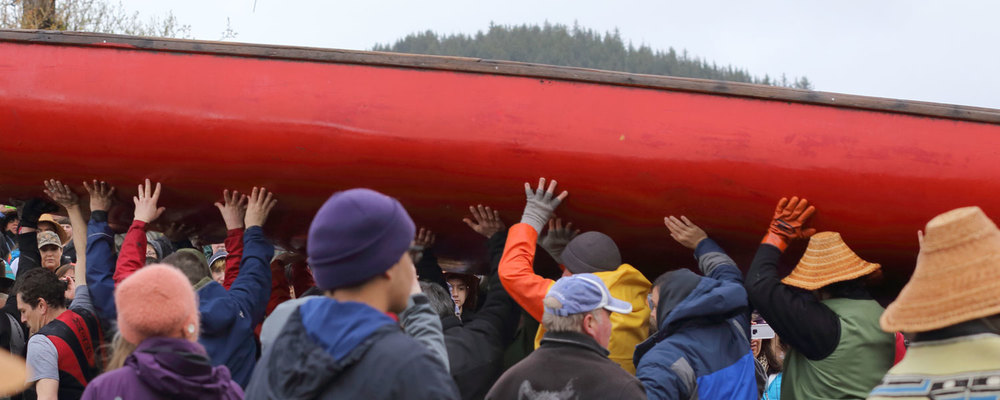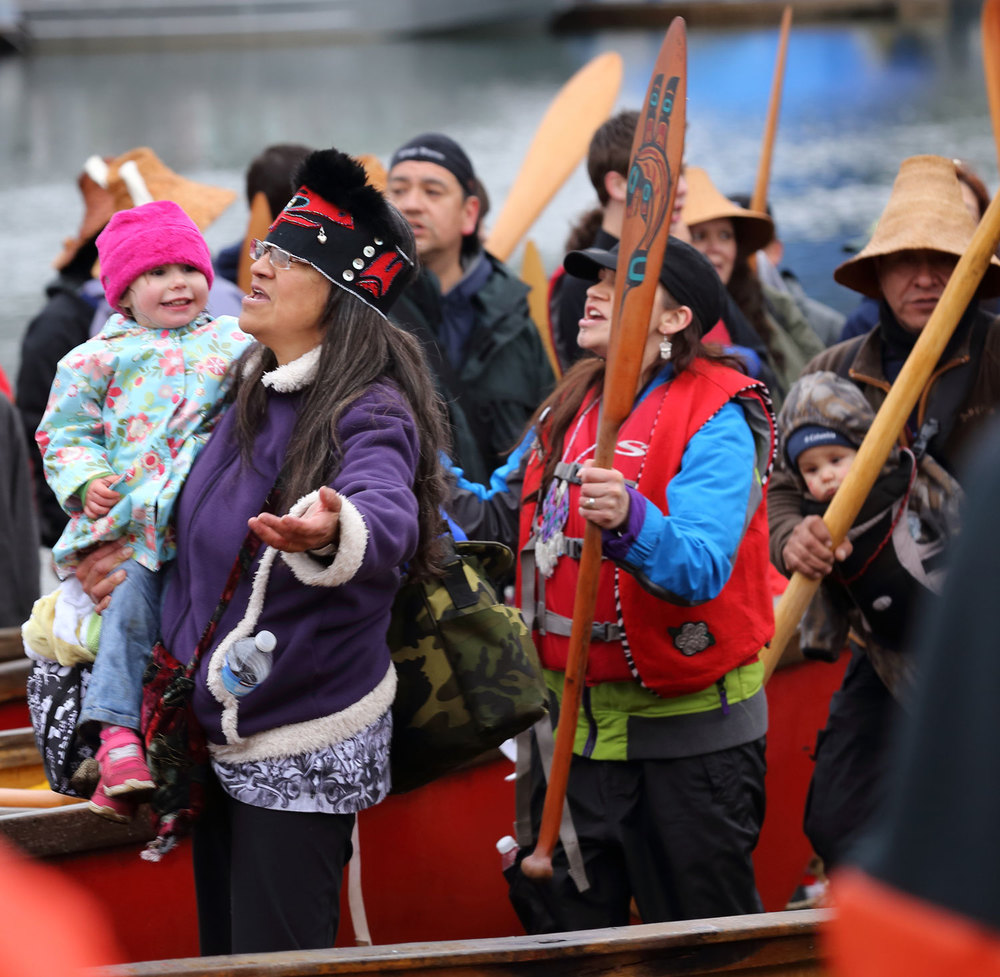Canoes Landing For Shakes Island Rededication
/Well let's see where we were....yesterday I left off right after the canoes came past the breakwater in to Wrangell Harbor...

Singing and drumming while paddling into the harbor.
...and were waiting for permission to come ashore...

...and I promised to show you some regalia and more about the canoes landing.
The Elders and clan leaders greeting the canoes are wearing Chilkat blankets. Some Chilkat blankets are very, very old. The Chilkat weaving technique is so complex that it can take one weaver a year to make one blanket. The designs are woven right into the fabric, not printed or painted on. Each of the design symbols has meaning, and meaning within meaning.
It gives me goosebumps to see all of these gorgeous cultural garments in one place. It makes me tear up to hear the language, singing, and drumming.

Alaska Native Elders and clan leaders wearing Chilkat and ravenstail blankets.
The black and white robe in the photo above is an example of ravenstail weaving. This is another very complex weaving technique. The methods were almost lost, but more people are learning to do Chilkat and ravenstail weaving now. Traditionally mountain goat hair and cedar bark would be used to make these blankets, and now other fibers supplement the weaver's supply basket.
The brown hats are woven of cedar bark. The bark is stripped off of a portion of the tree and then is painstakingly processed into long, slender strips, and soaked in water before being woven.
Carved hats and masks are a part of many Alaska Native cultures.

This man is wearing a Wolf mask. Another amazing work of art! The wood carving is embellished with ermine tails, a fox tail, and human hair. Abalone inlays create the eyes and whiskers. The teeth are dentalium shells and animal teeth; all items that would have been available to the Alaska Natives prior to the Russians and Europeans showing up.
Most of the dye and paint colors were available locally, and some were traded for. Copper oxide, alder bark, charcoal, and wolf lichen were some of the sources of color.

Greeting the canoes and calling them to shore.

One by one the canoes were given permission to land. The crews had traveled far, and were given fresh water.
The big canoes were lifted and carried by many hands, up the beach, through the crowd, safely to the high tide line.


Carrying the canoe up the beach.
And then there was singing and dancing and drumming all around as people slowly moved up the beach, between the canoes, and on to more celebration.



Alaska Native Elders and clan leaders dancing after the canoes landed on Shakes Island.
The event was recorded on hundreds of cameras. A professional videographer was present, and a news reporter for the local radio station captured the voices and drums.

Dancing between the canoes and through the cameras.
And there were patient photo ops...

The Alaska Native Elders and clan leaders who greeted the canoes and called for them to land at Shakes Island during the rededication celebration.

Alaska Native family in regalia
The woman in the photo at right above is wearing a traditional button blanket. She told me that her mother made it for her.

Through the ceremony and celebration all of the generations were present, respectfully watching and caring for each other.
The joyous strength of people coming together to dedicate a building that symbolizes and houses their culture created an energy that lifts all people and cultures.
I lift a glass of fresh, clean rain water to the tykes watching, canoe paddles in hand, ready to help propel the boat forward,
Alaska Beachcomber
More posts on Native culture: Shakes Island Rededication, Details in a Small Totem Park, Alaska Native Cedar Bark Hats
You may also enjoy: Collecting Devil's Club Root, Making Devil's Club Salve and Tincture
Great finds
- Casino Sites UK
- Best UK Non Gamstop Casinos
- Non Gamstop Casinos
- Non Gamstop Casinos
- UK Casinos Not On Gamstop
- Non Gamstop Casino
- Gambling Sites Not On Gamstop
- Non Gamstop Casino
- Non Gamstop Casino
- Non Gamstop Casino Sites UK
- UK Casino Not On Gamstop
- Meilleur Casino En Ligne
- Gambling Sites Not On Gamstop
- Best Casinos Not On Gamstop
- I Migliori Casino Non Aams
- Non Gamstop Casino Sites UK
- Casino Sites Not On Gamstop
- Non Gamstop Casino
- Casinos Not On Gamstop
- Slots Not On Gamstop
- Non Gamstop Casino Sites UK
- Casino Non Aams Sicuri




















